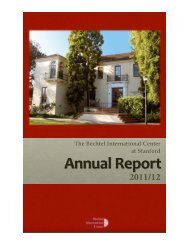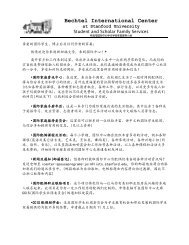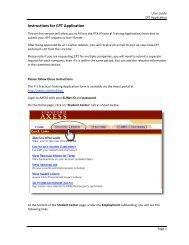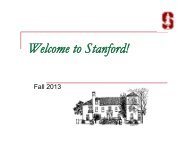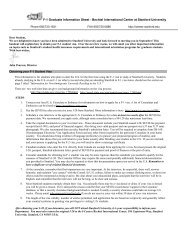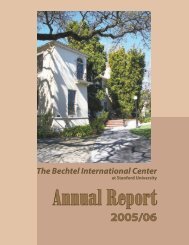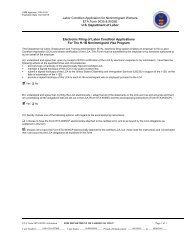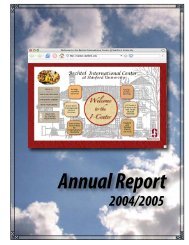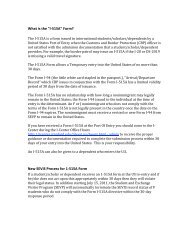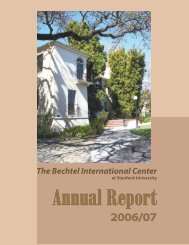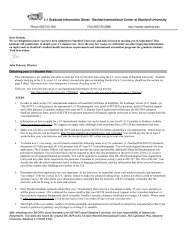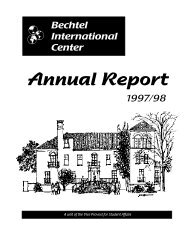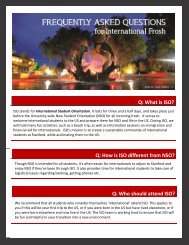Download - Bechtel International Center - Stanford University
Download - Bechtel International Center - Stanford University
Download - Bechtel International Center - Stanford University
Create successful ePaper yourself
Turn your PDF publications into a flip-book with our unique Google optimized e-Paper software.
• Add New Site of Activity<br />
• Delete a Site of Activity<br />
• Update Subject/Field Code Program of Activity<br />
• Change/Extend Program of Activity<br />
• Update Matriculation<br />
• Correct Minor/Technical Infraction of Regulations<br />
• Terminate EV from Program<br />
• Completion of Program of Activity<br />
• Bring Dependent (s) to US<br />
• Dependent (s) Departure<br />
• End Status for Dependent (s)<br />
Whether to use a third party software product or take<br />
advantage of the proposed SEVIS Patch that was being<br />
offered by PeopleSoft. It was decided to use the<br />
PeopleSoft PASS solution (Patriot Act SEVIS Solution).<br />
During the fall of 2002, and indeed throughout the entire<br />
academic year, regular meetings were held with representatives<br />
from the I-<strong>Center</strong>, ITSS, Registrar’s Office, and<br />
School Officials to develop a working process for<br />
implementing PASS. It was clear in fall of 2002 that<br />
<strong>Stanford</strong> would not be ready to batch information to<br />
SEVIS by the January 30, 2003 deadline and that RTI<br />
would have to be used for a considerable time after<br />
January 30. This proved to be the case and batch<br />
processing through PASS was not available until the late<br />
summer of 2003.<br />
In addition it soon became clear that PASS was focusing<br />
initially on F-1 students, and leaving the issue of J-1 visa<br />
holders until later. This meant that RTI was the only<br />
practical solution for J-1 visa holders until the academic<br />
year 2003-2004.<br />
Small working groups, within the I-<strong>Center</strong>, but also<br />
utilizing other office expertise, began meeting to<br />
evaluate the work processes that would need revising<br />
and to tabulate the issues that would arise when we<br />
began using SEVIS on a day-to-day basis. Once the final<br />
SEVIS regulations were published in December of 2002,<br />
this process took on more urgency as it became clear<br />
that 1) some of the regulations were not clear and 2)<br />
some routine work procedures could not be done<br />
through the batch process.<br />
During the summer of 2002 and fall of 2003 the I-<strong>Center</strong><br />
requested additional, temporary, staff support in order to<br />
be able to meet the compliance requirements of SEVIS in<br />
the first year of operation. The December 2002 regulations<br />
stated that before August 1, 2003 all continuing F-1<br />
and J-1 visa holders (and their dependents) had to be<br />
entered into PASS. This amounted to nearly 4,000<br />
records, all of which would need to be entered one by<br />
one through RTI. Before this could be done all files<br />
would need to be checked to assure the accuracy of<br />
data, a check that included both paper files and those<br />
residing in PeopleSoft.<br />
Because much of the work of implementing SEVIS was<br />
tied to using the PASS product it was decided, in January<br />
2003, that ITSS would provide funds for two one year<br />
temporary positions. Suffice it to say, that without these<br />
positions, we would not have been able to meet the<br />
August 1 deadline imposed by federal regulation.<br />
On September 18, 2002, INS published an interim final<br />
SEVIS rule requiring certification of all approved schools<br />
by January 30, 2003. The certification involved an on-line<br />
form, followed by a site visit. Schools were also to be recertified<br />
every two years. <strong>Stanford</strong> completed this<br />
process in the fall of 2002 and was approved as a SEVIS<br />
school in early January 2003.<br />
It was clear that SEVIS would have a major impact on the<br />
way our work was structured. In order to better evaluate<br />
this, the I-<strong>Center</strong> requested guidance from the Dean of<br />
Students and Vice-Provost for Student Affairs to develop<br />
a long-term strategy for assessing our work procedures<br />
and responsibilities. In July 2003 John Pearson met with<br />
colleagues from <strong>University</strong> of Pennsylvania, Duke,<br />
Columbia, and Yale to share concerns and advice about<br />
the longer term affects of SEVIS on international offices.<br />
It was also clear that, in order to implement SEVIS we<br />
would also need to inform the campus community of the<br />
details of this new requirement. In order to accomplish<br />
this the I-<strong>Center</strong>:<br />
• Placed an ad in the <strong>Stanford</strong> Daily explaining<br />
the details of the system and responsibilities<br />
placed on <strong>Stanford</strong><br />
• Offered regular workshops and information<br />
sessions for departmental administrators<br />
• Produced numerous Web based documents that<br />
explained SEVIS and it’s impact on the campus.<br />
These documents can be found on http://<br />
icenter.<strong>Stanford</strong>.edu<br />
• Provided email and web information for<br />
students on a regular basis<br />
10 <strong>Bechtel</strong> <strong>International</strong> <strong>Center</strong> Annual Report 2002-2003



